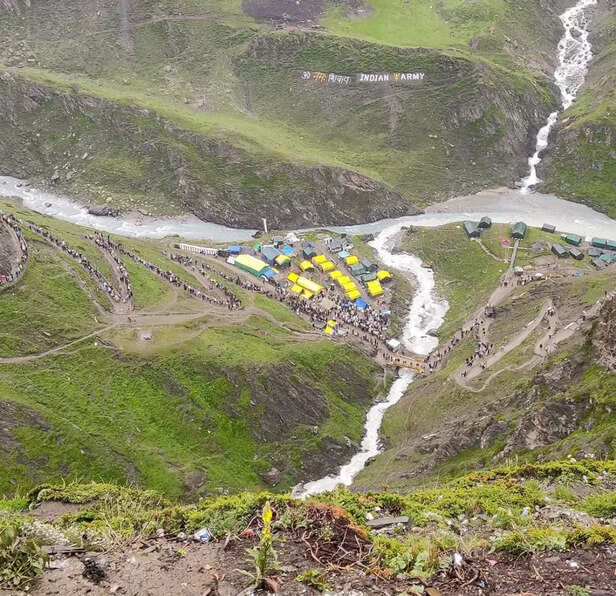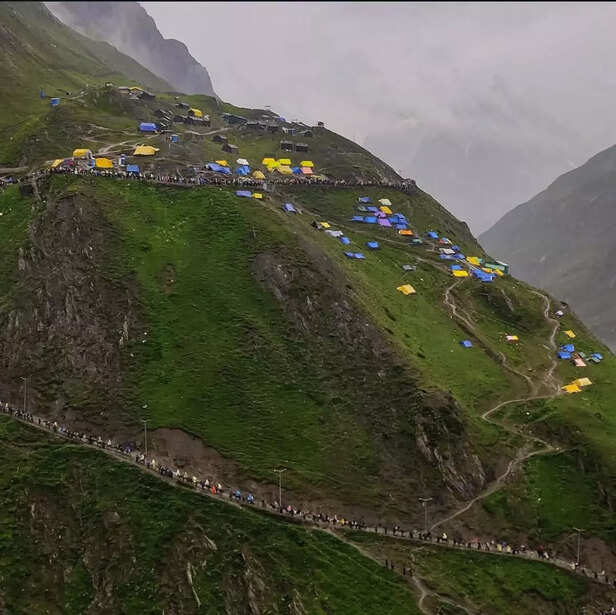Amarnath Yatra 2025 : What Every Devotee Must Know Before They Go!
Ankita Rai | Wed, 16 Apr 2025
Planning to embark on the sacred Amarnath Yatra 2025? This comprehensive guide covers everything you need—from registration procedures and route options to health requirements and travel tips. Discover the spiritual significance of the Amarnath cave temple, understand your route choices, and get all essential updates to make your pilgrimage smooth, safe, and deeply meaningful. Perfect for first-time travelers and seasoned devotees alike.

Photo:
The ancient Amarnath Yatra unveils a spiritual journey through the Kashmir Himalayas where devotees encounter Shiva's sacred ice lingam. Thousands embark each summer despite the treacherous terrain to Chandanwari, Pahalgam or Baltal, the main routes winding among glacial pools and sheer peaks. Pilgrims must register through the Shrine Board's portal, banks or app before the July launch, submitting health certificates and documentation for the RFID tracking system. This arduous yet awe-inspiring pilgrimage tests travelers' physical and mental limits but also renews faith. From Srinagar or Jammu, buses ascend the twisting mountain roads before trekkers continue on foot or pony toward the Amarnath cave. Shelters and langars provide sustenance along the way as joys and solace come through encounters with sadhus or the natural splendors of alpine meadows and mountain streams. Devotees sing bhajans and chant the sacred Om to bolster their stamina.Reaching over 14,000 feet, the shrine itself shelters in a narrow gorge where Lingam stones form miraculously each summer. Pilgrims brave the throng for sacred darshan then begin the taxing descent. Helicopter services also operate for those unable to complete the full trek. Throughout the 59-day season from early July until August, the Shrine Board carefully regulates daily quotas and infrastructure to accommodate pilgrims safely. Their perseverance and surrender offer spiritual renewal during this sublime Himalayan adventure.

Those embarking on the sacred Amarnath trek have two primary routes from which to choose, each with distinct elevation gains, scenery, and challenges. Understanding the route options well in advance is important when selecting the trail best suited to one’s fitness and available time. The traditional, longer Pahalgam route traces 48 kilometers over three to five days. Starting from the town of Pahalgam in Anantnag, it winds through Chandanwari and the spacious meadows of Pissu Top before the steep ascent to the Sheshnag lake. Beyond the crystal waters lies the village of Panchtarni, followed by the final approach to the holy Amarnath cave. Those drawn to a gentle climb amid scenic vistas find their pace here. As a shorter, more intense alternative, the 14-kilometer Baltal route can be completed in one to two days, depending on one’s stamina. Setting out from Baltal in Ganderbal, this path loses no beauty but trades sweeping valleys for a compact itinerary well-suited for those with robust health. Both trails offer helicopter services from their starting points to Panchtarni, allowing time-constrained pilgrims a partial airborne experience before six kilometers on foot to the destinations ice lingam. Advance booking through approved agencies avoids the risk of scam.
The Significance of the

Situated loftily at 3,888 meters, the Amarnath cave holds immense religious significance as the legendary site where Lord Shiva shared eternal truths with Goddess Parvati. Pilgrims flock to witness the awe-inspiring formation and dissolution of ice Sivalinga in rhythm with the moon’s phases.

Proper preparation through physical training well before the trek remains essential given the terrain’s high elevations and demands. Pilgrims would be wise to follow SASB’s safety guidelines closely, beginning with light cardiovascular exercise a month in advance.
Carry layered warm clothing, waterproof jackets, trekking boots, and walking sticks. Bring energy snacks, water bottles, basic medication, and personal hygiene supplies. Keep printed and digital copies of your Amarnath Yatra registration, ID proof, and RFID card are crucial. Those with cardiac, respiratory, or severe altitude-related conditions should avoid the strenuous Yatra. Do not ignore official advisories or engage in environmental negligence like littering. The beautiful yet physically demanding Amarnath Yatra is closely monitored by the Indian Army, CRPF, and local administration to ensure round-the-clock safety with emergency medical services readily available along both routes.

Pilgrims have access to various lodging options along both routes including government lodges and tents at campsites as well as private accommodations at the base camps of Baltal and scenic Pahalgam, offering a range of accommodation from basic facilities to slightly more amenities. Bookings can be made in advance through official platforms or trusted operators though expect functionality over luxury given the terrain. Srinagar Airport, well-connected to major Indian cities, is the nearest airport to reach the Amarnath region. Alternatively, Jammu Tawi Railway Station is the major railhead with onward road travel to the base camps. Typically pilgrims journey by taxi or bus from Jammu to either Baltal, taking the more challenging direct path, or to beautiful Pahalgam traversing the scenic yet longer route. Reach the base camp at least one day before your scheduled trek to properly acclimate and complete check-in procedures.

This profound spiritual experience demands thorough preparation, awareness of potential risks, and resilience to complete the physically demanding journey along rugged high-altitude routes. Whether taking the scenic but longer Pahalgam route or braving the challenges of Baltal, beholding the awe-inspiring divine presence of Shiva at the Amarnath cave temple makes the Yatra far beyond a mere religious obligation in this stunning yet unforgiving landscape. This Amarnath Yatra complete guide is designed to provide a structured and informative approach to ensure a smooth and meaningful pilgrimage. By following the official protocols and taking adequate precautions, devotees can experience the Yatra safely and spiritually fulfilled. However, the journey presents challenges given the high altitude terrain and harsh weather conditions. Pilgrims must prepare well in advance by obtaining proper permits, acclimatizing to thin air, and packing essential supplies and warm clothing. Additionally, it is wise to check up-to-date weather forecasts prior to undertaking the pilgrimage to the holy cave. With thorough planning and care, one can navigate the difficulties of the journey and arrive at the shrines with reduced risk while gaining maximum spiritual reward.
Unlock insightful tips aninspiration on personal growth, productivity, and well-being. Stay motivated and updated with the latest at My Life XP.
Amarnath Yatra Route Map : Two Paths For Pilgrims

route to Amarnath mandir (Picture credit : Instagram)
Those embarking on the sacred Amarnath trek have two primary routes from which to choose, each with distinct elevation gains, scenery, and challenges. Understanding the route options well in advance is important when selecting the trail best suited to one’s fitness and available time. The traditional, longer Pahalgam route traces 48 kilometers over three to five days. Starting from the town of Pahalgam in Anantnag, it winds through Chandanwari and the spacious meadows of Pissu Top before the steep ascent to the Sheshnag lake. Beyond the crystal waters lies the village of Panchtarni, followed by the final approach to the holy Amarnath cave. Those drawn to a gentle climb amid scenic vistas find their pace here. As a shorter, more intense alternative, the 14-kilometer Baltal route can be completed in one to two days, depending on one’s stamina. Setting out from Baltal in Ganderbal, this path loses no beauty but trades sweeping valleys for a compact itinerary well-suited for those with robust health. Both trails offer helicopter services from their starting points to Panchtarni, allowing time-constrained pilgrims a partial airborne experience before six kilometers on foot to the destinations ice lingam. Advance booking through approved agencies avoids the risk of scam.
The Significance of the Amarnath Cave Temple

cave (Picture credit : Instagram)
Situated loftily at 3,888 meters, the Amarnath cave holds immense religious significance as the legendary site where Lord Shiva shared eternal truths with Goddess Parvati. Pilgrims flock to witness the awe-inspiring formation and dissolution of ice Sivalinga in rhythm with the moon’s phases.
Travel Preparation: Health, Safety, and Essentials

(Picture credit : Instagram)
Proper preparation through physical training well before the trek remains essential given the terrain’s high elevations and demands. Pilgrims would be wise to follow SASB’s safety guidelines closely, beginning with light cardiovascular exercise a month in advance.
Carry layered warm clothing, waterproof jackets, trekking boots, and walking sticks. Bring energy snacks, water bottles, basic medication, and personal hygiene supplies. Keep printed and digital copies of your Amarnath Yatra registration, ID proof, and RFID card are crucial. Those with cardiac, respiratory, or severe altitude-related conditions should avoid the strenuous Yatra. Do not ignore official advisories or engage in environmental negligence like littering. The beautiful yet physically demanding Amarnath Yatra is closely monitored by the Indian Army, CRPF, and local administration to ensure round-the-clock safety with emergency medical services readily available along both routes.
Accommodation and On-Route Facilities

Registration begins for Amarnath Yatra 2025, pilgrims queue up at 540 bank branches
( Image credit : IANS )
Pilgrims have access to various lodging options along both routes including government lodges and tents at campsites as well as private accommodations at the base camps of Baltal and scenic Pahalgam, offering a range of accommodation from basic facilities to slightly more amenities. Bookings can be made in advance through official platforms or trusted operators though expect functionality over luxury given the terrain. Srinagar Airport, well-connected to major Indian cities, is the nearest airport to reach the Amarnath region. Alternatively, Jammu Tawi Railway Station is the major railhead with onward road travel to the base camps. Typically pilgrims journey by taxi or bus from Jammu to either Baltal, taking the more challenging direct path, or to beautiful Pahalgam traversing the scenic yet longer route. Reach the base camp at least one day before your scheduled trek to properly acclimate and complete check-in procedures.
Conclusion: A Journey of Devotion and Discipline

Amarnath Temple (Picture credit : Instagram)
This profound spiritual experience demands thorough preparation, awareness of potential risks, and resilience to complete the physically demanding journey along rugged high-altitude routes. Whether taking the scenic but longer Pahalgam route or braving the challenges of Baltal, beholding the awe-inspiring divine presence of Shiva at the Amarnath cave temple makes the Yatra far beyond a mere religious obligation in this stunning yet unforgiving landscape. This Amarnath Yatra complete guide is designed to provide a structured and informative approach to ensure a smooth and meaningful pilgrimage. By following the official protocols and taking adequate precautions, devotees can experience the Yatra safely and spiritually fulfilled. However, the journey presents challenges given the high altitude terrain and harsh weather conditions. Pilgrims must prepare well in advance by obtaining proper permits, acclimatizing to thin air, and packing essential supplies and warm clothing. Additionally, it is wise to check up-to-date weather forecasts prior to undertaking the pilgrimage to the holy cave. With thorough planning and care, one can navigate the difficulties of the journey and arrive at the shrines with reduced risk while gaining maximum spiritual reward.
Unlock insightful tips aninspiration on personal growth, productivity, and well-being. Stay motivated and updated with the latest at My Life XP.
Frequently Asked Questions (FAQs)
- What are the rules for Amarnath Yatra?
Pilgrims must register in advance, carry a valid health certificate, obtain an RFID card, and follow the assigned travel date and route. - Who cannot go to Amarnath Yatra?
Children below 13, adults above 70, pregnant women, and individuals with certain health conditions are not permitted. - How many days are enough for Amarnath Yatra?
Typically, 3 to 5 days are sufficient depending on the chosen route and travel mode.









